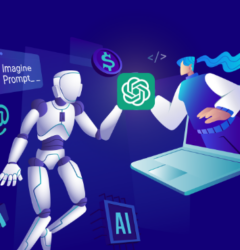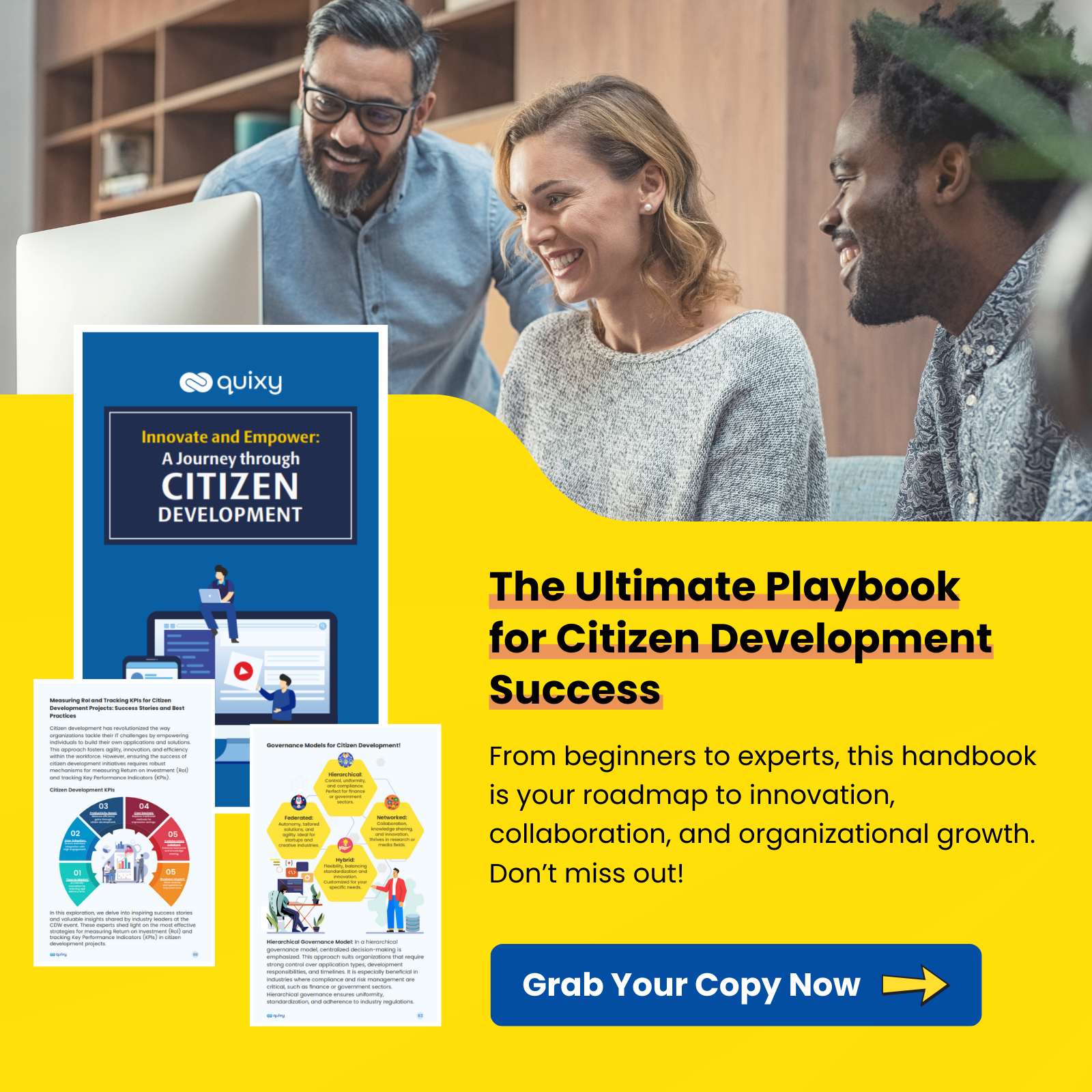
Innovation stands as the bedrock of success in the business and technology sphere. To stay at the forefront, businesses have redefined ideation, giving rise to Agile Idea Development—a dynamic approach harnessing citizen development and real-time innovation. Our blog discusses ideation’s evolution, unravels the essence of Agile Ideation, and offers profound insights into its core facets and far-reaching benefits.
The Evolution of Ideation: From Traditional to Agile Idea Development
Ideation, at its core, is the process of generating and refining ideas to address challenges and seize opportunities. Traditionally, ideation involved brainstorming sessions, often confined to designated teams within an organization. While this approach generated valuable ideas, it was limited in scope and often lacked the agility required to swiftly adapt to changing market dynamics.
Agile Ideation marks a significant departure from this traditional model. It embraces the concept of citizen developers (CDs), individuals who may not possess formal coding backgrounds but contribute to ideation and app development through their unique perspectives. This democratization of idea generation fosters diversity and creativity, resulting in a broader array of potential solutions.
Harnessing the Power of Citizen Developers in Agile Idea Development
The true magic of Agile Idea Development lies in its ability to tap into the collective intelligence of citizen developers. These individuals bring diverse skill sets and viewpoints to the table, enriching the ideation process. By involving non-technical stakeholders, organizations gain a holistic understanding of challenges and can develop solutions that resonate with a wider audience.
Key Objectives and Benefits of Agile Idea Development
The objectives of Agile Idea Development are clear: to quickly identify and implement technological solutions to business problems.
By integrating the expertise of citizen developers, companies can gather a multitude of ideas that might otherwise remain untapped. This approach not only expedites the innovation process but also minimizes paperwork and administrative burdens, fostering a more efficient development cycle.
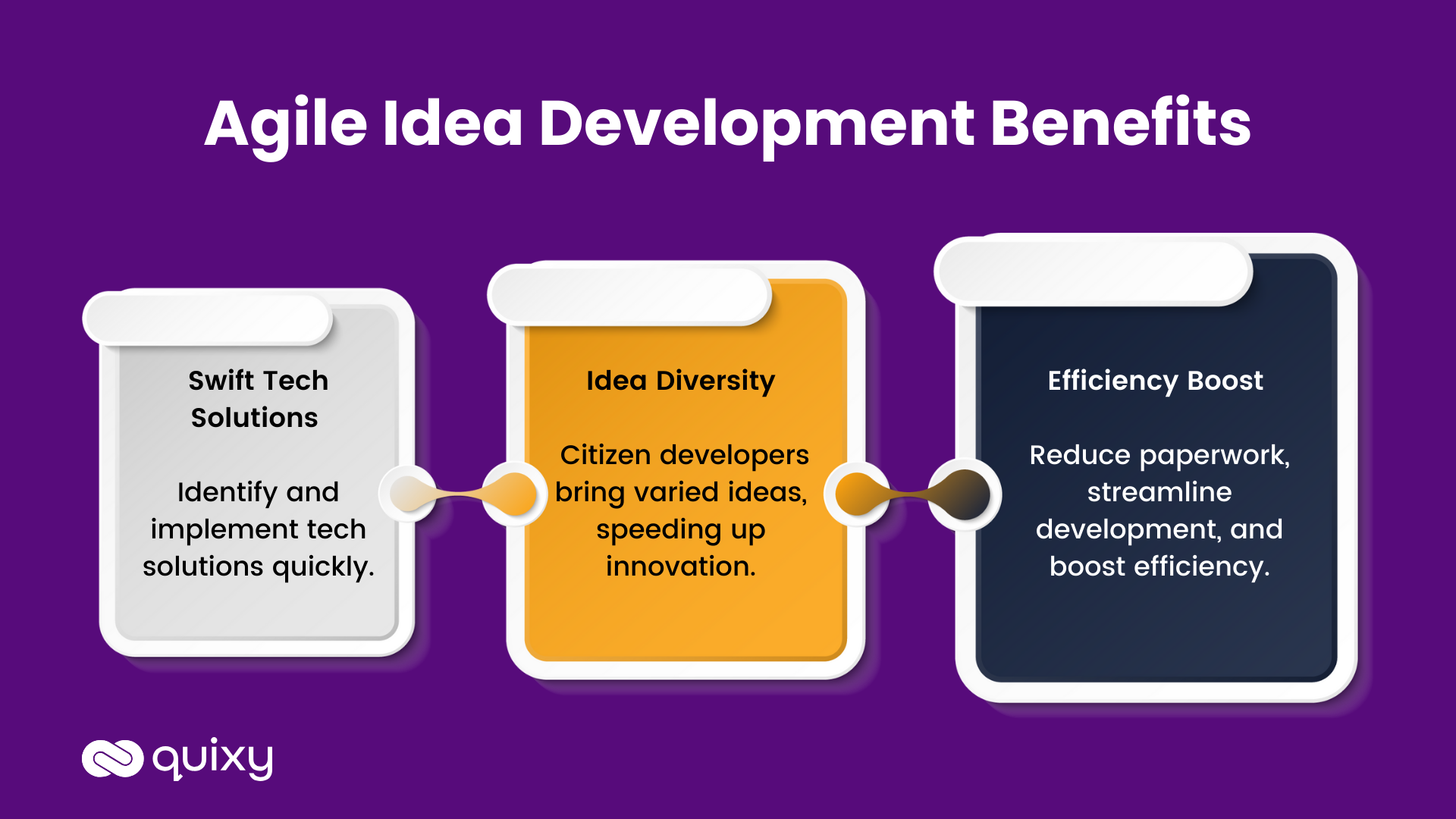
- Agile Idea Development aims to identify and implement tech solutions for business problems swiftly.
- Integration of citizen developers yields a multitude of ideas, expediting innovation.
- Minimized paperwork and admin burdens streamline development, enhancing efficiency.
The objectives of ideation, particularly in a business or creative context, include:
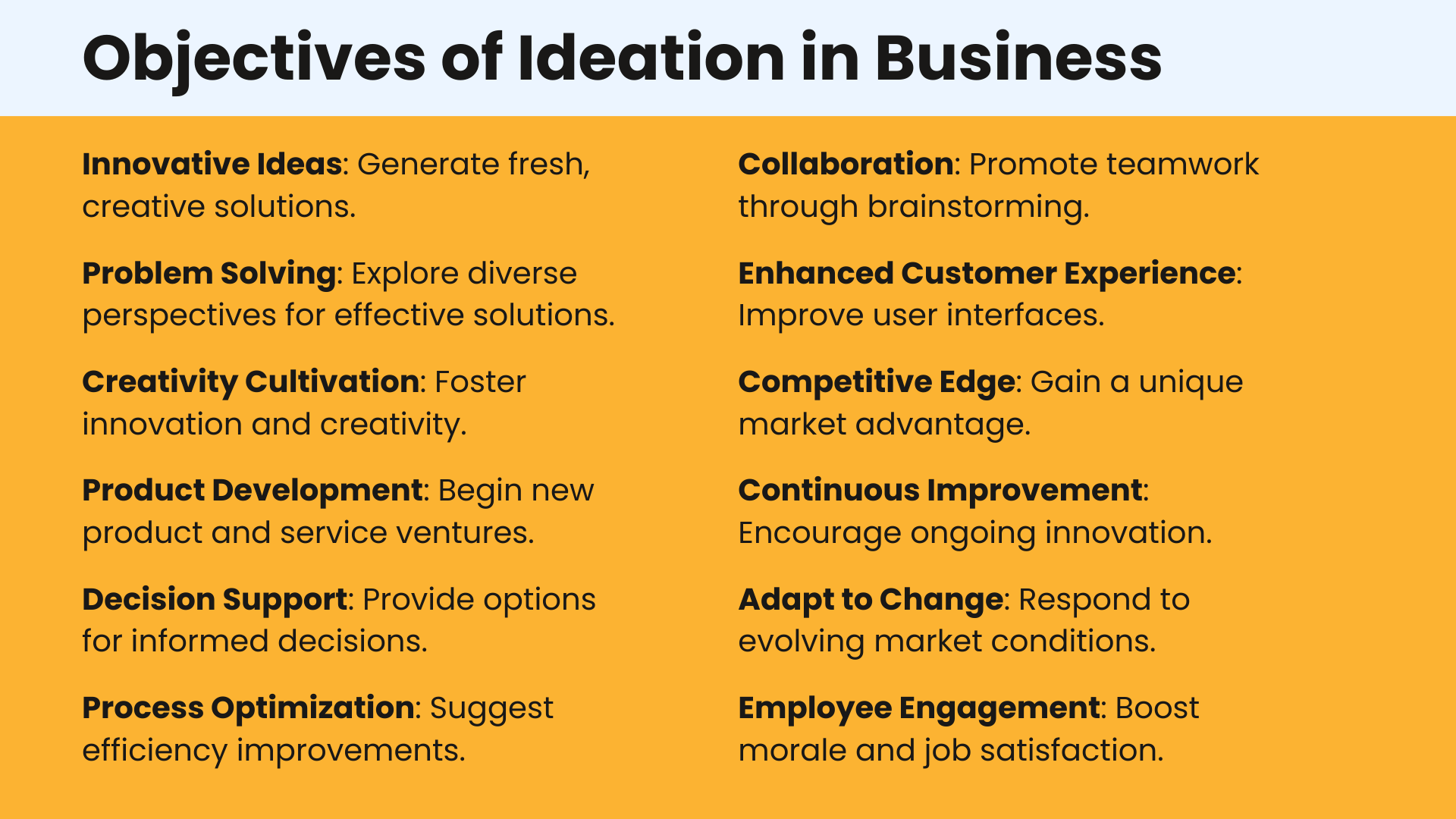
- Generate Innovative Ideas: Ideation aims to generate a wide range of fresh and innovative ideas that can address specific challenges, capitalize on opportunities, or drive creativity within an organization.
- Problem Solving: Ideation helps in solving complex problems by exploring various perspectives, approaches, and solutions to find the most effective and efficient way to overcome challenges.
- Enhance Creativity: It encourages creative thinking and helps individuals and teams think outside the box, fostering an organization’s innovation culture.
- Product or Service Development: Ideation is often the starting point for developing new products, services, or solutions that can meet the needs and preferences of customers or users.
- Decision-Making Support: Ideation provides a range of options and ideas that can aid in informed decision-making, helping organizations choose the best course of action.
- Optimize Processes: It can lead to suggestions for process improvements, operational efficiencies, and cost-saving measures.
- Encourage Collaboration: Ideation often involves brainstorming sessions where team members collaborate, share ideas, and build on each other’s thoughts, promoting teamwork and synergy.
- Enhance Customer Experience: Ideas generated through ideation can lead to enhancements in the customer experience by identifying and addressing pain points and improving user interfaces.
- Competitive Advantage: By generating unique and innovative ideas, ideation can help organizations gain a competitive edge in their industry.
- Continuous Improvement: Ideation is an ongoing process, and its objective is not limited to a single event. It encourages a culture of continuous improvement and innovation within an organization.
- Adaptation to Change: Ideation allows organizations to adapt to changing market conditions, technological advancements, and evolving customer preferences by generating ideas for adaptation and transformation.
- Employee Engagement: Encouraging employees to participate in ideation can boost morale, engagement, and job satisfaction by making them feel valued for their contributions.
Overall, the objectives of ideation revolve around fostering creativity, innovation, problem-solving, and continuous improvement within an organization, ultimately leading to better outcomes and competitiveness in the market.
Also Read: Citizen Development Value Tree: A Comprehensive Guide
Guidelines for Generating and Refining Ideas
In Agile Idea Development, idea generation is a collaborative endeavor. Cross-functional teams, including citizen developers, converge to brainstorm, discuss, and refine ideas. This collaborative process ensures a comprehensive exploration of potential solutions.
In Agile Idea Development:
- Idea generation becomes a collaborative effort.
- Cross-functional teams and citizen developers converge.
- Brainstorming, discussion, and idea refinement occur.
- A comprehensive exploration of potential solutions ensues.
Key Aspects of Agile Idea Development
Step into the dynamic world of Agile Idea Development, where innovation unfurls its wings through adaptability, customer-centricity, and the rhythmic dance of iterative progress.
1. Scope Creep: Embracing Adaptability for Success
One of the intriguing aspects of Agile Idea Development is its approach to scope creep. Traditionally frowned upon in software development, Agile Ideation embraces scope creep, understanding that small adjustments can lead to more adaptable and successful solutions.
2. Iteration: The Engine of Continuous Improvement
The heart of Agile Idea Development lies in its iterative nature. Frequent iterations enable continuous improvement and allow teams to incorporate feedback at every stage of development. These iterations are characterized by squad meetings where ideas are floated, refined, and implemented. Evaluation of outcomes informs subsequent iterations, creating a cycle of refinement and enhancement.
3. Real-Time Development: Accelerating Innovation with Agility
Real-time development is a hallmark of Agile Ideation. Rather than waiting for extensive documentation and design, this approach emphasizes developing and refining apps concurrently. This is possible due to the speed, cost-effectiveness, and reduced risk associated with citizen developer-led development.
Agile Ideation represents a paradigm shift in how businesses approach innovation. By embracing citizen developers, leveraging iterative processes, and emphasizing real-time development, organizations can propel themselves into a realm of rapid ideation and agile problem-solving. As technology continues to advance, the evolution of ideation stands as a testament to the transformative power of collaborative and adaptive thinking.
Also Read: Measuring ROI and Tracking Citizen Development KPIs
Agile Idea Development: Guiding Principles for Dynamic Idea Refinement
In the realm of Agile Idea Development, the process of generating and refining ideas transcends traditional boundaries. It goes beyond linear models, embracing an agile and collaborative approach. This sub-section sheds light on the fundamental guidelines that underscore Agile Idea Development’s transformative journey.
1. Concurrent Idea Refinement and Development
Gone are the days of isolated idea refinement at the onset of a project. In Agile Idea Development, the refinement of ideas occurs in tandem with the development of solutions. This seamless integration ensures that creativity and practicality evolve together, resulting in more relevant and potent solutions.
2. Nonlinear Inspiration and Stakeholder Diversity
Agile Idea Development thrives on nonlinear inspiration. It roots itself in a profound comprehension of problems and the broader landscape. However, it doesn’t rely solely on internal viewpoints. Rather, it draws from stakeholders across the organization, each offering diverse perspectives and areas of expertise, enriching the process with comprehensive insights.
3. Collaborative Iterations: The Heartbeat of Agile Idea Development
Collaboration is the cornerstone of Agile Ideation’s iterative refinement. The process flourishes through a minimum of two cycles of idea refinement and real-time solution building, conducted collaboratively. These iterations amplify the quality of ideas, harnessing collective intelligence to drive innovation.
- A Lifecycle Encompassing Approach: Agile Ideation’s efficacy spans the entire project lifecycle. From concept to execution, its principles can be applied. It doesn’t merely stop when the solution is deployed; it continues to thrive even in the live environment, effectively facilitating focus group sessions with end-users for further enhancement.
- A Versatile Tool for Diverse Scenarios: Agile Idea Development is not constrained by scenarios or project stages. It thrives throughout the Software Development Life Cycle (SDLC) and extends its benefits when new applications are conceived or existing ones are updated or extended.
- Accelerating Ideation through Agile Creation: Agile Idea Development brings the notion of speed to the forefront. With a Citizen Developer Practitioner leading the way, a working application prototype can materialize and be tested in real time. This agility eradicates inefficiencies inherent in traditional IT-based development, erasing multiple hand-offs, backlogs, cumbersome documentation, and the fear of scope creep.
Embracing Agile Ideation isn’t just about change; it’s about redefining the creative landscape and innovation paradigm. It’s about breaking free from conventional boundaries and welcoming a collaborative, iterative, and dynamic approach to idea refinement that resonates from concept to execution.
Also Read: What is Citizen Development: A Comprehensive Guide
Defining Citizen Developers and their Significance in Ideation
In the realm of Agile Idea Development, Citizen Developers are emerging as crucial players. These are individuals within your organization who possess domain knowledge but may not have traditional coding backgrounds. Their significance lies in their ability to bridge the gap between conceptualizing innovative ideas and bringing them to life. Citizen Developers have a unique understanding of business processes, making them valuable contributors to the ideation process.
1. Speeding Up the Ideation Process with Citizen Developer Involvement
Incorporating Citizen Developers into your ideation process can significantly accelerate the journey from idea to execution. Their domain expertise allows for quicker identification of potential challenges and opportunities. By involving Citizen Developers early on, you tap into a wealth of practical knowledge that can streamline decision-making and reduce the time it takes to transform ideas into actionable projects.
2. Size and Definition of the Squad: Optimal Team Composition
To fully harness the potential of Citizen Developers in Agile Idea Development, it’s essential to define the squad’s composition thoughtfully. A well-balanced team typically includes members with diverse skill sets. In addition to Citizen Developers, consider involving IT professionals, subject matter experts, designers, and project managers. This blend of skills ensures that ideation is not only innovative but also feasible and efficiently executed.
Roles and Responsibilities of Squad Members in Ideation
1. Identifying and Aligning Key Roles (RACI MATRIX)
A critical aspect of effective ideation with Citizen Developers is defining and aligning key roles within the squad. This is where the RACI (Responsible, Accountable, Consulted, Informed) matrix comes into play. It assigns clear responsibilities for each team member, ensuring that everyone understands their role in the ideation process. Citizen Developers often take on the role of “Responsible” or “Consulted” due to their deep domain knowledge.
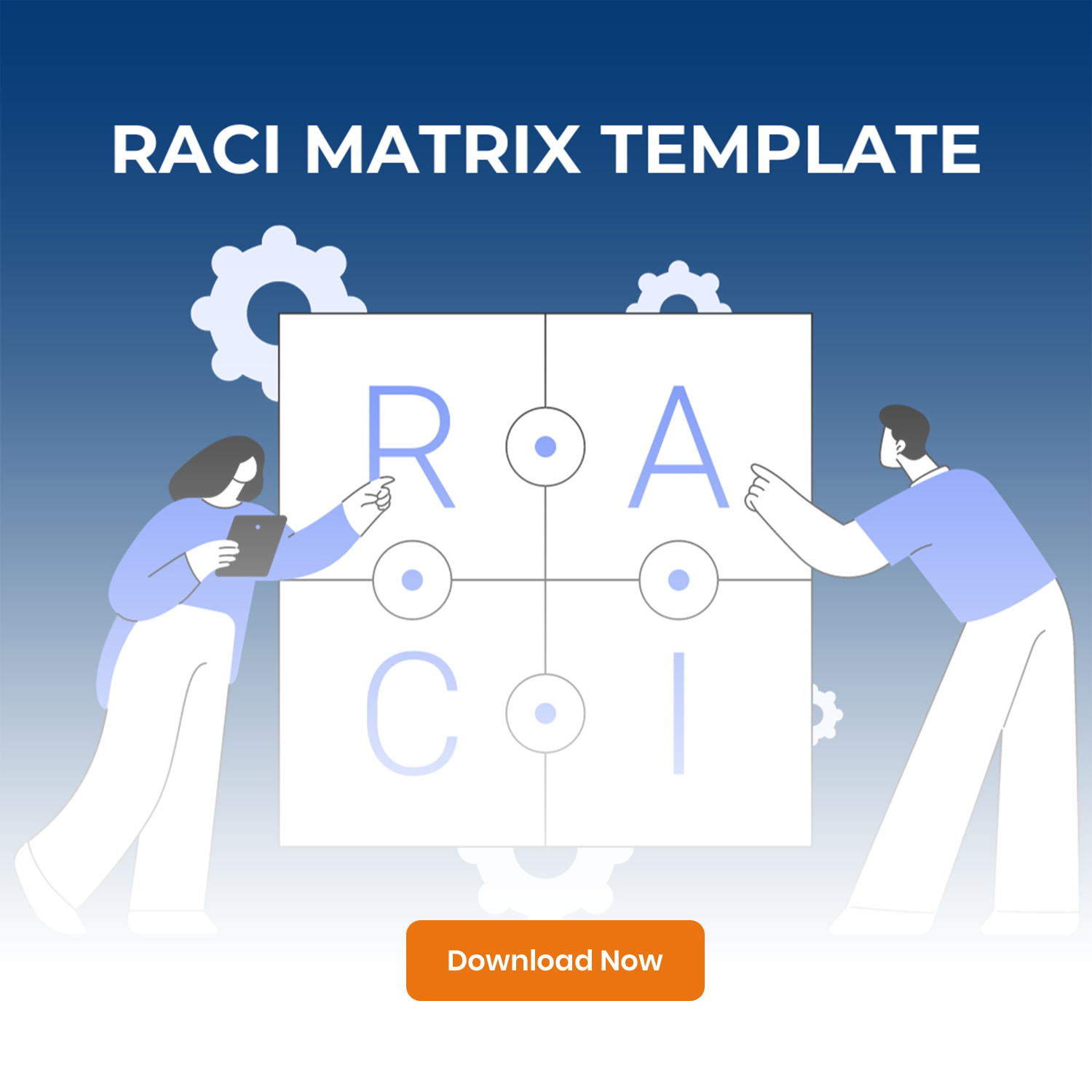
2. Empowering Citizen Developers with Ownership and Decision-Making
Empowering Citizen Developers involves more than just recognizing their input; it’s about giving them ownership and decision-making authority. When they feel ownership over their ideas, they are more likely to champion and execute them effectively. Additionally, involving Citizen Developers in decision-making processes fosters a sense of belonging and encourages them to contribute their best ideas fearlessly.
In the landscape of Idea Development, Citizen Developers are a valuable asset. Their unique perspective and hands-on involvement can be the catalyst for transformative ideas and efficient execution. By embracing their contributions and empowering them within your organization’s ideation process, you unlock the full potential of Agile Idea Development.

Methods of Agile Idea Development(Techniques)
Discover five exciting techniques that power Agile Idea Development, from real-time brainstorming to user beta testing. Get ready to unlock creativity and turn your ideas into reality!
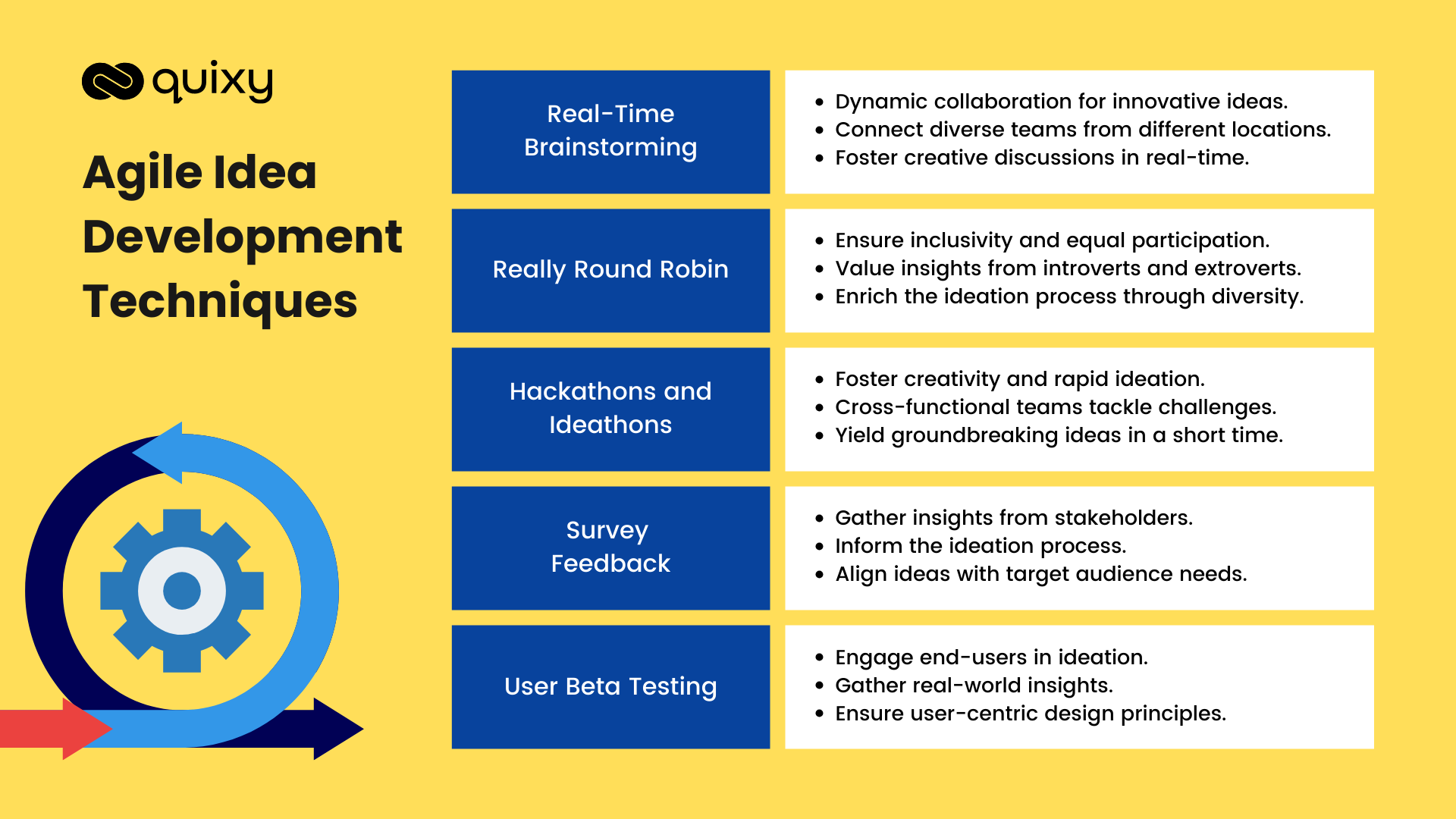
1. Real-Time Brainstorming: The Core of Agile Idea Development
Real-time brainstorming is the heart of Agile Idea Development. It’s a dynamic process where diverse minds come together to generate innovative ideas. Unlike traditional brainstorming, which can be limited by time and location, Agile Ideation’s real-time brainstorming leverages technology to facilitate collaborative idea generation. Teams from different locations can join, contributing their expertise, and sparking creative discussions in real-time.
2. Really Round Robin: Ensuring Inclusivity and Equal Participation
Agile Ideation embraces the “Really Round Robin” approach to ensure inclusivity and equal participation. This technique guarantees that every team member has the opportunity to share their thoughts and ideas. It fosters an environment where introverts and extroverts alike can contribute, ensuring that no valuable insights are overlooked. This approach encourages diversity and enriches the ideation process.
3. Hackathons and Ideathons: Fostering Creativity and Rapid Ideation
Hackathons and Ideathons are intensive events designed to foster creativity and rapid ideation. They bring together cross-functional teams to work collaboratively on solving specific challenges or generating innovative ideas. These time-bound events encourage participants to think outside the box, push boundaries, and develop practical solutions. Hackathons and Ideathons are known for their ability to yield groundbreaking ideas in a short period.
4. Survey Feedback: Gathering Insights from Stakeholders
Incorporating feedback from stakeholders is a crucial aspect of Agile Idea Development. Surveys are an effective method to gather insights and opinions from a wide range of stakeholders, including customers, employees, and partners. These insights can then be used to inform the ideation process, ensuring that the resulting ideas align with the needs and expectations of the target audience.
5. User Beta Testing: Engaging Users in the Ideation Process
User beta testing takes Agile Idea Development a step further by directly involving end-users in the ideation process. It allows organizations to gather feedback from those who will ultimately use the product or service. User beta testing provides real-world insights, helping refine ideas, uncover potential issues, and ensure that the final solution meets user expectations. This technique aligns ideation with user-centric design principles.
These methods and techniques form the foundation of Agile Idea Development, a dynamic and inclusive approach to idea generation and innovation. By embracing these practices, organizations can tap into the collective creativity of their teams and stakeholders, resulting in more impactful and successful ideas.
Outputs of Agile Idea Development
Let’s explore the fantastic outcomes that result from Agile Idea Development techniques. From visualizing project direction with the Product Vision Board to prioritizing user-centric design through User Stories, we’ll unveil how these dynamic methods propel your ideas to success most engagingly and straightforwardly.
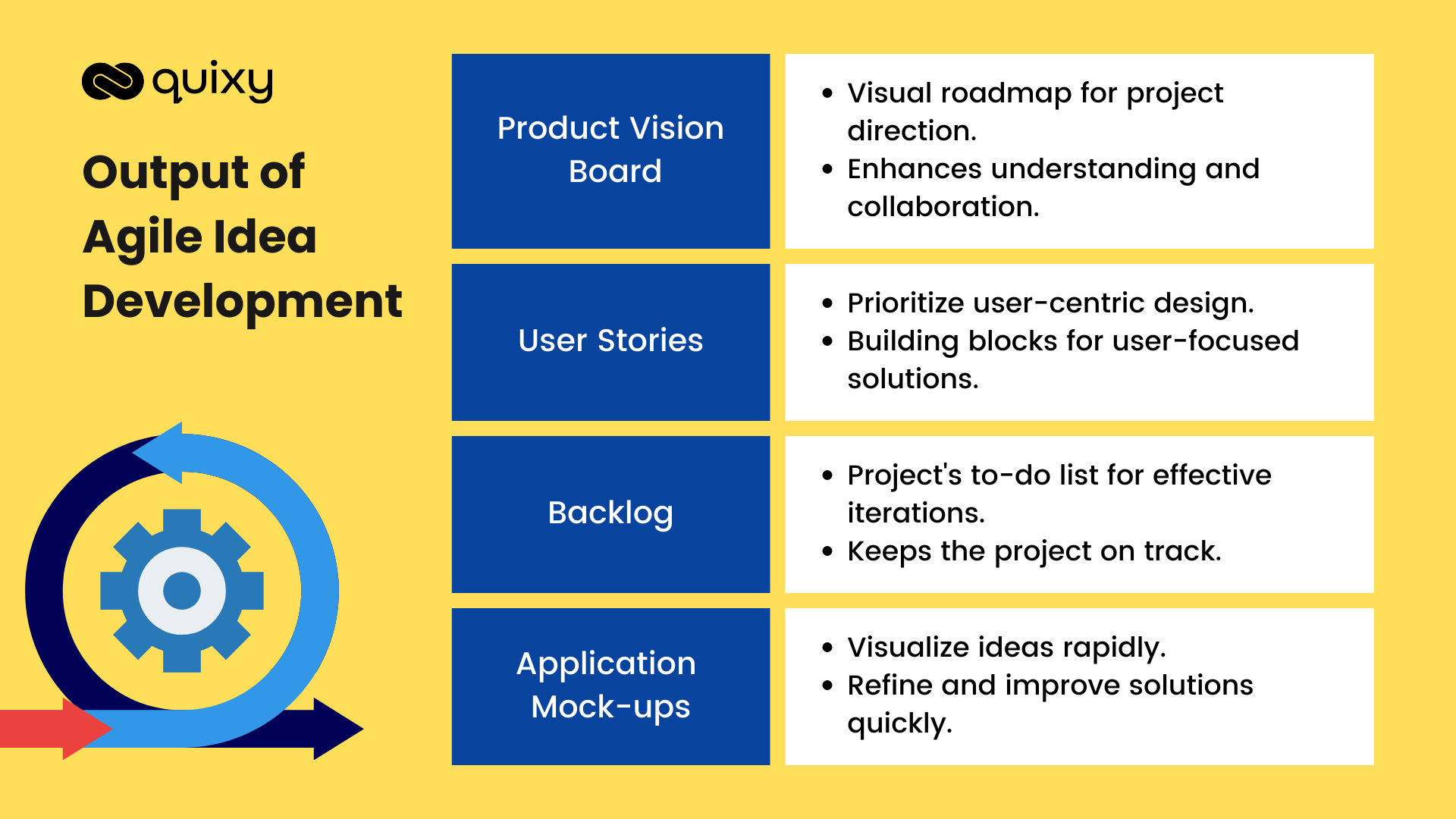
Let’s dive in and discover how Agile Idea Development transforms concepts into reality!
1. Product Vision Board: Charting the Project’s Path
Imagine a visual roadmap that guides your project’s direction – that’s the Product Vision Board. It helps everyone understand where you’re headed, making it easier to get there together.
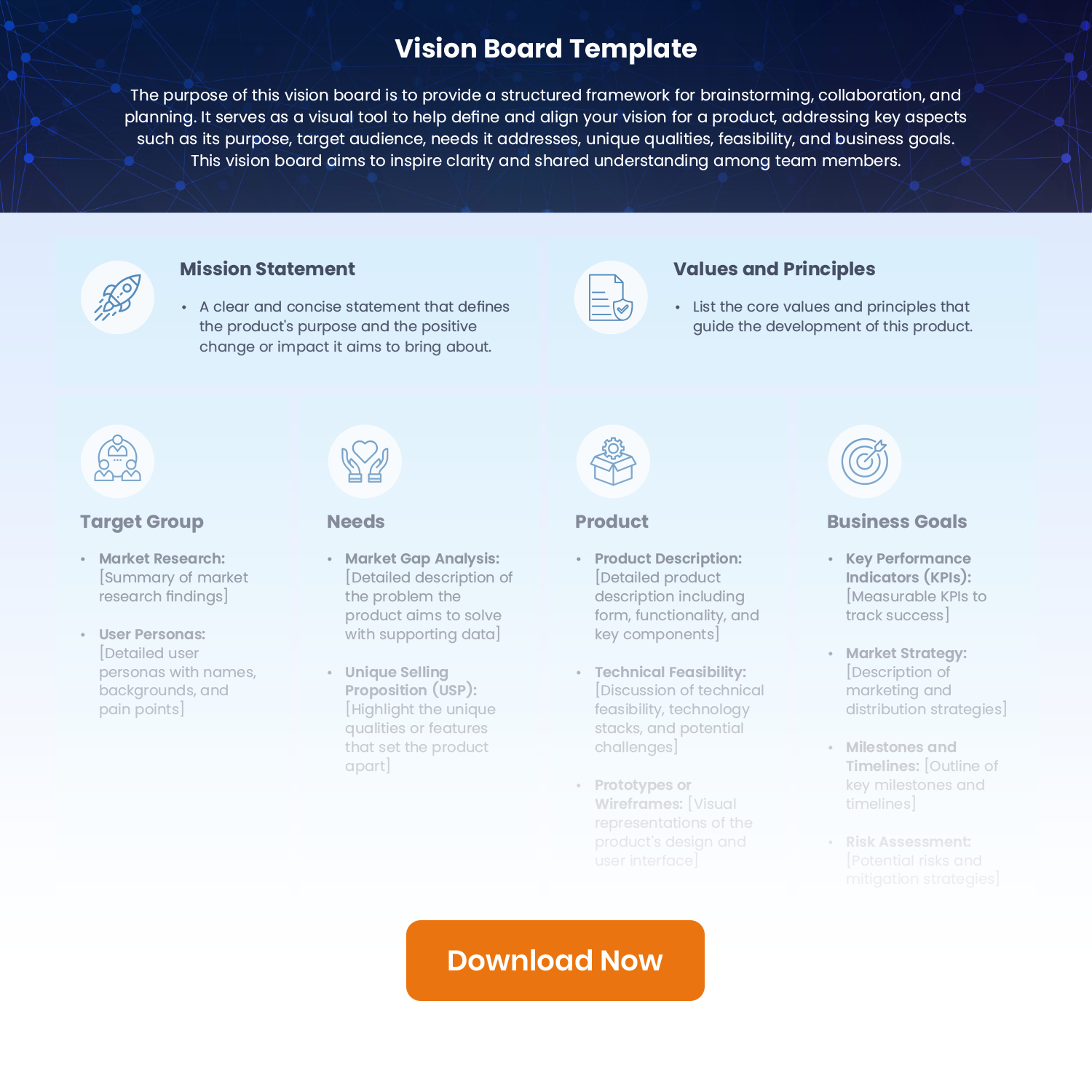
2. User Stories: Putting Users First
User Stories put users at the heart of your design. They’re like building blocks that help prioritize what really matters to the people who’ll use your product.
Also Read: Citizen Development: The Yoda way to knock IT backlogs out of the park!
3. Backlog: Keeping Things on Track
Think of the Backlog as your project’s to-do list. It’s where you manage what needs to be done, ensuring your project stays on course through effective iterations.
4. Application Mock-ups: Bringing Ideas to Life Rapidly
Application Mock-ups are like visual sketches of your solutions. They let you see your ideas in action quickly, helping you refine and improve them.
Agile Idea Development for Innovation
- Streamlining Idea Refinement Throughout the Design Process: Agile Idea Development brings efficiency to idea refinement at every stage of the design process.
- Accelerating Time-to-Value with Real-Time Development: Agile Ideation generates ideas and accelerates their transformation into tangible value. Real-time development techniques are at the forefront of this process.
- Driving Continuous Improvement in Product Development: Agile Idea Development paves the way for continuous improvement in product development. It’s not just about ideation; it’s about refining and evolving your product for ongoing success.
Overcoming Challenges in Agile Idea Development
- Control Scope Creep: Stay on Course – Overcome scope creep by defining clear objectives and maintaining regular communication with stakeholders. RACI Matrix can help you here. A robust change management process can help you adapt to evolving requirements without derailing your project.
- Leverage Iteration: Evolve for Success – Embrace the iterative nature of Agile Idea Development. By breaking your project into manageable iterations, you can continually gather feedback, learn from each phase, and refine your ideas for better outcomes.
- Optimize Real-Time Development: Balance Speed and Quality – Achieving a balance between speed and quality in real-time development is possible. Prioritize tasks, streamline workflows, and invest in automation to accelerate delivery without compromising on the quality of your solutions.
Also Read: Navigating the Agile Framework Essential Insights for Modern Business
The Future of Ideation and Citizen Development
The Future of Ideation and Citizen Development is a thrilling journey into the realm of innovation and technological progress. As we move forward, Agile Idea Development stands to benefit immensely from the ever-evolving landscape of emerging technologies. These innovations are not just changing how we think; they’re shaping how we generate ideas and innovate.
Citizen developers’ role is gaining prominence in this landscape, with their unique perspectives and skills playing a pivotal part in driving innovation. As we explore the growing impact of Citizen Developers, it becomes clear that they are poised to be a driving force in shaping the future of ideation, enabling organizations to harness the full potential of their creative talent for transformative change.
Conclusion
As we conclude, remember that Agile Idea Development is all about agile, collaborative innovation. It’s a dynamic approach that empowers organizations to turn ideas into realities.
Empower your Citizen Developers as they drive organizational success through innovation. Agile Idea Development is a gateway to unlocking their potential and achieving transformative outcomes.
Frequently Asked Questions(FAQs)
Q. Why is idea development important for apps?
Idea development is crucial for apps as it sets the foundation for a successful project. A well-thought-out concept ensures that your app addresses real needs, stands out in the market, and attracts users.
Q. How can I generate innovative app ideas?
Generating innovative app ideas involves brainstorming, researching user needs, and staying updated on industry trends. Encourage creativity within your team and explore unique solutions to common problems.
Q. What’s the process for refining and validating my app idea?
To refine and validate your app idea, start with market research and user feedback. Create prototypes, conduct usability testing, and iterate based on the results. This iterative approach ensures your idea aligns with user expectations.
Q. How do I protect my app idea during development?
Consider non-disclosure agreements, patents, or trademarks to protect your app idea. Additionally, maintain a record of your development process and communicate discreetly with your team and partners.
Q. What’s the role of user feedback in app idea development?
User feedback is invaluable for refining your app idea. It helps you understand user preferences, identify pain points, and make necessary adjustments. This iterative feedback loop ensures your app caters to user needs effectively.
Login
Please login to comment
0 Comments
Oldest
